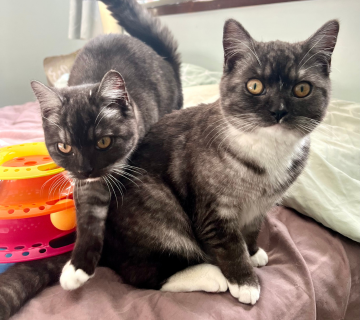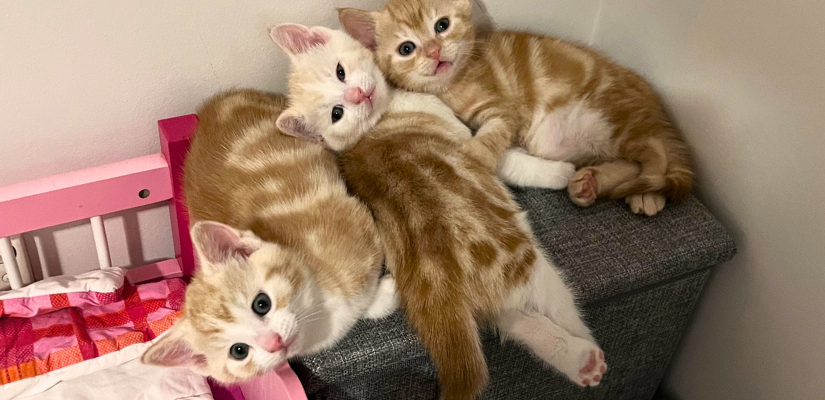It probably won’t come as a surprise to you that humans have loved – and even praised – cats for a very, very long time. For thousands of years, across the world, and across cultures, in fact!
Despite being feared by some, or seen as bad omens, cats have generally been revered for their mystical, mysterious nature, as well as their ability to chase away creatures like rats and therefore reduce the spread of disease and protect households.
The cats of ancient myth may seem like a far cry from the purring, lazy fur baby that’s currently curled up at the foot of your bed. But once you learn the way they have interacted with culture and humanity throughout time, it’ll be clear to see why they’re revered as magical beings.
Let’s take a journey across the world to see how cats have influenced cultures through time
The Middle East: Cats in Ancient Egypt & Islamic Tradition
In the history of the human-cat relationship, the Middle East holds a significant place, particularly due to the profound significance of cats in ancient Egyptian mythology. Still, the feline’s impact extended far beyond Egypt, influencing the perception of cats in various Middle Eastern cultures.
Ancient Egypt: A Land of Cat Worship
Ancient Egypt, located in the northeastern corner of Africa, is one of the earliest known civilisations to have deeply revered and even deified cats. They enjoyed a prominent place in Egyptian households, where cats were considered not just pets but sacred beings.
The veneration of cats was epitomised by the goddess Bastet, who had the body of a woman and the head of a lioness or domestic cat. Bastet, the goddess of home, fertility, and childbirth, was also a guardian against evil spirits. She was closely associated with cats and was often depicted holding or accompanied by them. Bastet’s dual nature, like that of cats, represented both protective and destructive qualities. When pleased, she brought prosperity and good fortune, but when angered, she could unleash chaos and destruction.
Cats in ancient Egypt also played roles as protective symbols. They were believed to possess the power to ward off evil spirits, making them valuable household guardians. Killing a cat, even accidentally, could result in severe consequences, sometimes including death.
The influence of cats in ancient Egypt was not confined to the country’s borders. Egyptian traders and conquerors introduced these venerated animals to other parts of the Middle East, disseminating their importance. As a result, the reverence for cats began to spread across the region, influencing various Middle Eastern cultures.
Cats in Islamic Traditions
The influence of cats in the Middle East extends beyond ancient Egypt and is also notable in Islamic culture. Cats, while not directly worshipped in Islam, hold a significant place due to their association with the Prophet Muhammad. According to Islamic tradition, cats are viewed with reverence and kindness, reflecting the Prophet’s admiration for these creatures.
An Islamic hadith, or narration of the Prophet Muhammad, states that a woman was granted paradise for showing compassion to a thirsty cat by giving it water to drink. This story has contributed to the Islamic view of cats as deserving of kindness and care.
Cats’ importance remains evident today in Islamic societies and households. They are viewed as symbols of cleanliness and are respected for their hygiene habits. In Islamic cultures, cleanliness is a vital aspect of the faith, and the affinity for cats’ grooming habits aligns with the emphasis on purity.
Asia: Mystical Cats in Eastern Mythology
The continent of Asia is rich in folklore and ancient traditions, often attributing mystical significance to cats. The reverence for cats that remains today echoes the animals’ mystical and sometimes otherworldly connection in the mythology of the East, signifying luck, protection, and guardian spirits.
Japan’s Maneki-Neko
In Japanese culture, the image of the Maneki-Neko, the “beckoning cat”, remains an iconic symbol of good luck and fortune. Depicted with one paw raised, it is believed to attract prosperity and positive energy to the household or business it graces. Legends suggest it saved a man from a storm by signalling to him from a temple with its beckoning paw, encouraging him to take shelter. That legend continues to influence Japanese culture even now, with cats beloved as fortune-bringing creatures.
Chinese Myth
In China, the cat holds a special place in mythology. A legend tells that when the world first began, the gods appointed cats to oversee things. The cat goddess, Li Shou, represented the felines, and when they spent all their time lazing in the sun, she had to explain to the gods that they didn’t care to rule – just to sit and relax! So, humans were given the responsibility of running the world instead.
Conversely, tigers are especially renowned in Chinese folklore, for their strength and ferocity. This reverence extends to their smaller counterparts.
Indian Symbolism
In Indian religion and culture, particularly Hinduism, cats have significant places. They are ridden by Shashti Mata, a goddess, and are often symbolised as bringers of life due to the way they carry their kittens in their mouths. Shasthi Mata and cats are seen as protectors of mothers and children, and symbols of fertility. It is more popular in Indian cultures to revere big cats like tigers, but cats are still respected and loved.
Europe: Cats and Folklore
In European folklore, the perception of cats has been diverse, reflecting a range of contrasting beliefs. The animals have often been associated with superstitions and seen as bad omens.
Cats have often been linked to witchcraft and paganism in European cultures. Their nocturnal activities and agile behaviour were misunderstood, leading to suspicion and fear. The idea of witches’ familiars or companions was born, in which cats were thought to be companions to witches, working as their supernatural aides. Unfortunately, many cats fell victim to superstition and were mistreated or even persecuted.
This negative association has had a lasting impact on the perception of cats in Western culture. While times have evolved, and understanding has improved, echoes of these misconceptions can still be seen in superstitions. For example, black cats are sometimes considered unlucky, particularly in some regions. Yet, these beliefs are fading away with increasing awareness and education.
Despite this negative historical context, the reputation of cats in Western cultures has also been redeemed. They are cherished as beloved pets and companions, and are invaluable for their natural pest control abilities, especially in rural areas. Their graceful and charming nature often overshadows the superstitions of the past.
The Americas: Feline Myths in Indigenous Cultures
In the Americas, cats and feline figures held various symbolic significances in the beliefs of Indigenous cultures. Throughout the Americas, cats in indigenous mythologies have symbolised various virtues, including strength, guardianship, wisdom, and protection. These representations continue to be cherished and hold spiritual value in several indigenous communities, representing a deep connection between humans and nature.
In North America, cats were a rare sight (especially in the domesticated form) before European colonisation, when they were brought over on ships. Wildcats, meanwhile, were often considered pests by many tribes – selfish creatures that were held in low esteem. The diversity of Native American tribes, and the lack of cat presence before colonisation, means there isn’t a strong or common presence for cats in legend. Although stories about cats exist, they tend to be specific to individual tribes.
Heading south to Mexico and beyond, the ancient civilisations of Mesoamerica, like the Aztecs and Mayans, revered the jaguar, a native feline, as a symbol of power and divinity. The most powerful cat of the Americas, this big feline was associated with strength, prowess, and authority. The jaguar was thought to possess supernatural abilities and was considered a guardian of the underworld.
In South American folklore, particularly in Peru, the mystical Palla cat was a revered creature, often associated with shamanistic rituals and seen as a protector against evil spirits. These cats held spiritual significance, believed to guide and protect individuals on their spiritual journeys. In Argentina, the Hombre Gato (Catman) is a legendary predator mixed between a human and a feline.
Africa: Cats in African Beliefs
In the rich tapestry of African mythology, cats play diverse and significant roles, reflecting the cultural and spiritual beliefs of various regions. But don’t confuse the Egyptians’ reverence of their small cats with the way cats have been seen in the rest of Africa. Across the continent’s vast geography, cultures, flora and fauna, people were more likely to come across a lion or panther than a housecat.
In many African cultures, cats are regarded as protectors. They are seen as guardians against evil spirits and negative energies. The silent and stealthy nature of cats is often associated with vigilance and the ability to ward off malevolent forces. In this context, having a cat in or around one’s home is believed to bring a sense of security and spiritual protection.
However, some cultures believe that cats can be evil or demonic, especially black cats, due to superstitious legends.
Oceania: Cats in Island Mythology
Cats were first introduced to Australia in the 1800s, with European colonisation. This means there aren’t any ancient Aboriginal or Torres Strait Islander legends to look at for an example of cats in Australian mythology. Although housecats are beloved by people in Australia, they’re an invasive species that pose big threats to native wildlife. Today, Australians try their best to keep cats safe by taking them off the streets, desexing them so they can’t keep breeding and creating a bigger invasive population, and by keeping their own pet cats indoors so they’re less of a threat to native wildlife.
Across the rest of Oceania, the culture around cats is similar. While some pacific islands remain cat free, most of the world has been introduced to felines, and our responsibility as humans is to protect them as well as the creatures they might harm.
Contemporary Views and Their Mythical Roots
As we bridge the gap between ancient myths and the present day, it becomes evident that the captivating tales of cats in mythology continue to exert their influence on contemporary perspectives. From ancient deities to revered protectors and mysterious familiars, the mythical roots of cats have woven a narrative that extends beyond folklore into the realms of modern media and popular culture.
Exploring the contemporary portrayal of cats, we witness their dynamic roles in literature, art, and cinema. Whether cast as magical companions, symbols of mystery, or adorable internet sensations, cats maintain an enduring allure that echoes the mythical reverence they commanded in ancient stories. Unravelling the threads of these mythical roots in today’s cultural landscape provides a fascinating lens through which we can appreciate the evolving relationship between humans and these enigmatic feline beings.
In our odyssey through the continents and cultures, we’ve traced the footprints of cats across the annals of mythology. From the revered goddess Bastet in ancient Egypt to the mischievous and magical creatures in European folklore, cats have left an indelible mark on the tapestry of human storytelling. Their roles as protectors, companions, and symbols of luck have transcended time and borders, weaving a universal narrative that speaks to the profound and enduring connection between humans and cats.

Are you looking to adopt a pet or donate to a pet rescue organisation? Georgie and Cindy from Large Hope SEO foster cats and kittens on the Sunshine Coast in Australia. If you’re local, get in touch to discuss adopting from the rescues. See cats and kittens available for adoption or donate so we can save more kittens.
 seolounge
seolounge